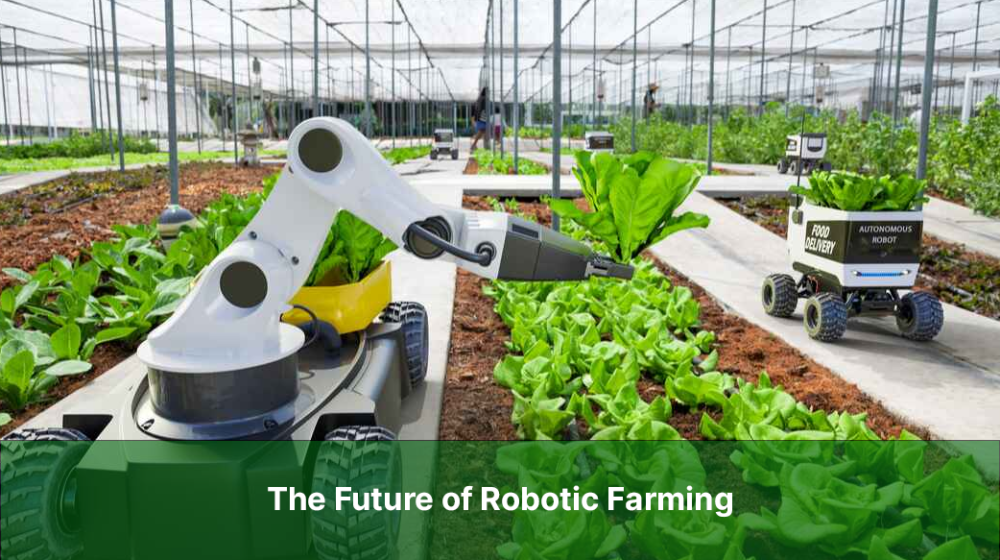The agricultural industry is facing a number of challenges, including a growing population, climate change, and a shortage of labor. In order to meet these challenges, farmers are increasingly turning to robotic technology.
Robotic farming is a rapidly developing field that has the potential to revolutionize the way we produce food. Robots can be used to perform a variety of tasks, such as planting, weeding, harvesting, and transporting crops. They can also be used to monitor crops for pests and diseases, and to apply fertilizers and pesticides.
The use of robotic technology in farming has a number of advantages. Robots can work 24 hours a day, 7 days a week, and they are not susceptible to fatigue or injury. They are also more precise than human workers, and they can collect and analyze data that can be used to improve crop yields.
However, there are also some challenges associated with robotic farming. Robots can be expensive, and they may not be suitable for all types of farms. They also require a high level of technical expertise to operate and maintain.
Despite the challenges, the future of robotic farming is bright. As the technology continues to develop, the cost of robots will come down, and they will become more versatile and user-friendly. As a result, robotic farming is poised to become a major force in the agricultural industry.
Here are some of the benefits of robotic farming:
- Increased efficiency: Robots can perform tasks more quickly and accurately than human workers. This can lead to increased crop yields and reduced costs.
- Improved quality: Robots can apply pesticides and fertilizers more precisely than human workers. This can lead to healthier crops and higher quality produce.
- Reduced environmental impact: Robots can reduce the need for pesticides and fertilizers. This can help to protect the environment and improve food safety.
- Increased safety: Robots can work in dangerous or hazardous environments without putting human workers at risk.
Here are some of the challenges of robotic farming:
- Cost: Robots can be expensive to purchase and maintain.
- Technology: The technology for robotic farming is still developing, and there are some challenges to overcome, such as the need for robots to be able to navigate in a variety of conditions.
- Labor: Robots may not be able to replace all human labor in agriculture. There will still be a need for human workers to perform tasks such as planting and harvesting crops.
Overall, the future of robotic farming is promising. Robots have the potential to revolutionize the agricultural industry, making it more efficient, sustainable, and safe.
Here are some of the ways that robotic farming could impact the agricultural industry:
- Increased efficiency: Robots can perform tasks more quickly and accurately than human workers. This can lead to increased crop yields and reduced costs.
- Improved quality: Robots can apply pesticides and fertilizers more precisely than human workers. This can lead to healthier crops and higher quality produce.
- Reduced environmental impact: Robots can reduce the need for pesticides and fertilizers. This can help to protect the environment and improve food safety.
- Increased safety: Robots can work in dangerous or hazardous environments without putting human workers at risk.
Overall, robotic farming has the potential to make the agricultural industry more efficient, sustainable, and safe.
Is that dangerous for human being (Workers):
Robotic farming is not inherently dangerous for human beings. However, there are some potential risks associated with the use of robots in agriculture, such as:
- Robots could malfunction and injure or kill workers. This is a risk with any type of machinery, but it is especially important to consider with robots, which are often complex and operate autonomously.
- Robots could spread pesticides or fertilizers that are harmful to humans. This is a risk if robots are not properly programmed or if they are not properly maintained.
- Robots could damage crops or equipment. This is a risk if robots are not properly trained or if they are not properly supervised.
Robots can also potentially be dangerous to other animals, such as pets or livestock. It is important to take steps to mitigate these risks, such as:
- Training workers on how to safely operate and maintain robots.
- Developing safety protocols for using robots in agriculture.
- Ensuring that robots are properly programmed and maintained.
By taking these steps, we can help to ensure that robotic farming is safe for human beings and other animals.
